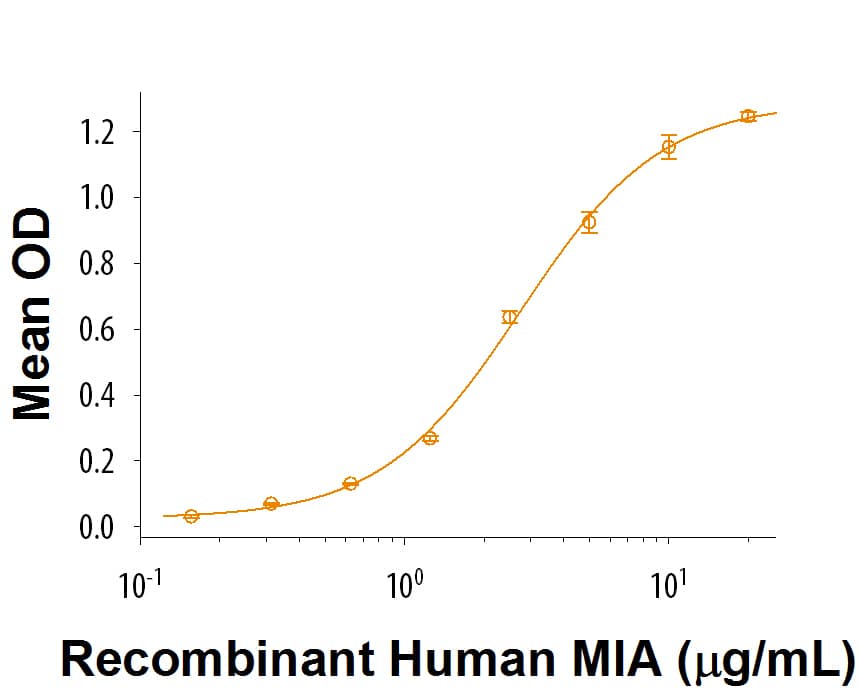Recombinant Human MIA Protein, CF
R&D Systems, part of Bio-Techne | Catalog # 9250-IA

Key Product Details
Product Specifications
Source
E. coli-derived human MIA protein
Gly25-Gln131, with an N-terminal Met
Gly25-Gln131, with an N-terminal Met
Purity
>95%, by SDS-PAGE with silver staining, under reducing conditions.
Endotoxin Level
<0.10 EU per 1 μg of the protein by the LAL method.
N-terminal Sequence Analysis
Met, Gly25
Predicted Molecular Mass
12 kDa
SDS-PAGE
10 kDa, reducing conditions
Activity
Measured by its binding ability in a functional ELISA.
When Recombinant Human Fibronectin Fragment 4 (Catalog # 3624-FN) is immubilized at 1 μg/mL, 100 μL/well, Recombinant Human MIA binds with a typical ED50 of 1-6 μg/mL.
When Recombinant Human Fibronectin Fragment 4 (Catalog # 3624-FN) is immubilized at 1 μg/mL, 100 μL/well, Recombinant Human MIA binds with a typical ED50 of 1-6 μg/mL.
Reviewed Applications
Read 1 review rated 5 using 9250-IA in the following applications:
Scientific Data Images for Recombinant Human MIA Protein, CF
Recombinant Human MIA Protein Bioactivity
When Recombinant Human Fibronectin Fragment 4 (Catalog # 3624-FN) is coated at 1 μg/mL, Recombinant Human MIA (Catalog # 9250-IA) binds with a typical ED50 of 1-6 μg/mL.Formulation, Preparation and Storage
9250-IA
| Formulation | Lyophilized from a 0.2 μm filtered solution in PBS and Trehalose. |
| Reconstitution |
Reconstitute at 400 μg/mL in PBS.
|
| Shipping | The product is shipped with polar packs. Upon receipt, store it immediately at the temperature recommended below. |
| Stability & Storage | Use a manual defrost freezer and avoid repeated freeze-thaw cycles.
|
Background: MIA
References
- Schmidt, J. et al. (2013) Histol. Histopathol. 28:421.
- Blesch, A. et al. (1994) Cancer Res. 54:5695.
- Hau, P. et al. (2002) J. Invest. Dermatol. 119:562.
- Lin, S. et al. (2008) Dev. Biol. 316:441.
- Bauer, R. et al. (2006) J. Biol. Chem. 281:11669.
- Tscheudschilsuren, G. et al. (2006) Exp. Cell Res. 312:63.
- Schmid, R. et al. (2010) Cell Death Dis. 1:e97.
- Marr, D.G. et al. (2004) Int. J. Oncol. 25:105.
- Sasahira, T. et al. (2010) Eur. J. Cancer 46:2285.
- El Fitori, J. et al. (2005) Cancer Cell Int. 5:3.
- Schmidt, J. et al. (2010) Cell Res. 20:1224.
- Schmidt, J. and A.K. Bosserhoff (2009) Int. J. Cancer 125:1587.
- Poser, I. et al. (2004) Oncogene 23:6115.
- Guba, M. et al. (2000) Brit. J. Cancer 83:1216.
Long Name
Melanoma Inhibitory Activity
Alternate Names
CD-RAP
Gene Symbol
MIA
UniProt
Additional MIA Products
Product Documents for Recombinant Human MIA Protein, CF
Product Specific Notices for Recombinant Human MIA Protein, CF
For research use only
